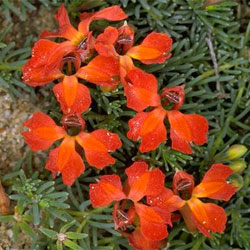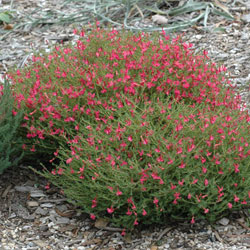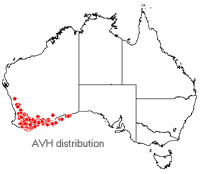Lechenaultia formosa
Red Lechenaultia
This species is a member of the Goodeniaceae, which is mostly a southern hemisphere family, while there are some species in the northern hemisphere. There is no common name for this species, although some people call it Red Lechenaultia in general.
L. formosa is endemic to southern Western Australia. Its favourite habitat is somewhere arid and sunny. You will see them widespread especially after fire or soil disturbance.
The plant is shrubby and never exceeds 50cm height. In ideal conditions it grows in a round shape like a carpet on the ground. Leaves are fleshy and small, about 4 to 9 mm long.
Flowers are about the size of thumbnail but very attractive due to the colour. Three of the five floral lobes are spreading, with showy broad wings on each side of the petal in a zygomorphic fan-shape. The other two are erect, with reduced wings.
Great variations in flower colour exist in the wild, which have been selected as cultivars. The colour ranges from rich red to bright yellow, or even different colours transiting on one flower.
Although it is nice to have a Lechenaultia carpet on the ground in your garden, growing it in pots is recommended when ground soil is constantly too wet for the plant.
Starting from November, the flowering period lasts from spring to early summer in Canberra. The plant can grow very well continuously for years. Pruning is not very necessary, but occasional pruning can give more flowers.
This plant is quite easy to grow. Well drained soil, like perlite potting mix, is good to keep the plant not very wet, helping it spread through the light-weight particles. As it naturally lives in an arid environment, it’s better to allow the plant access to plenty of sun light and low humidity. Only water when you find the soil dry for a couple of days.
Cutting is the preferred way to propagate. Take no more than 5cm long semi-hardwood branch. Tear off 2/3 of the older leaves from bottom. Keep some moisture to prevent dehydration. Hormone IBA/NAA can be applied to let it grow fast and strong.
Theoretically, growing the plant from seeds is possible, but some special treatments are needed, which is far less convenient and more difficult than cuttings.
This plant doesn’t require too much care, but some general common problems do exist. Although it is able to tolerate a low level of frost, heavy frost could be a problem in winter in some areas. The simple way to create a suitable microclimate for the plant is to let it face northwards, accessing the largest amount of sunlight during day time. Keeping it somewhere well ventilated is also important or the plant could be attacked by fungi.
Like many other horticultural plants, L. formosa also suffers from a variety of pests. Unfortunately, this species would not be very happy with pesticides. Therefore you will need to remove the pests by hand or use bio-control if possible. However, these pests are a seasonal problem and vary with different years…so you won’t be that busy all the time.
Text by Sue Shuyin Zhang (2011 Student Botanical Intern)
Name Meaning: Lechenaultia formosaLechenaultia – after the French botanist Leschenault de la Tour (1773-1826). formosa – meaning ‘beautiful’. |
References
Carolin, R.C. et al. (1992) Flora of Australia 35, pp 4-12, 34, Australian Government Publishing Service, Canberra.
Clarke, B. (2011) Horticulturist, Australian National Botanic Gardens. Pers. comm.
Elliot, W.R. & Jones, D.L. (1993) Encyclopaedia of Australian Plants Suitable for Cultivation, vol. 6, pp72-74, Thomas C Lothian Pty. Ltd, Melbourne.
![An Australian Government Initiative [logo]](/images/austgovt_brown_90px.gif)




